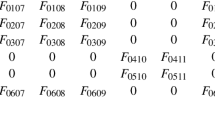Summary
A set of displacement equations of motion suitable for describing the dynamic behavior of composite materials is derived. The composite material may be a fiber-reinforced composite or a particulate composite. The composite is represented by a lattice model in which the continuous mass distribution of the actual body is replaced by a system of springs attached to small rigid masses. Effective values are determined for the masses of the rigid bodies and the stiffnesses of the springs. The kinetic and strain energies stored in an extended composite medium are expressed in terms of the displacements at the positions of the mass points. By employing Taylor series expansions, and by replacing summations by integrations, representative kinetic and strain energy densities are obtained. Thus, transition to a continuum is achieved. Subsequent application of Hamilton's principle gives the displacement equations of motion which are of the same form as those of a first strain-gradient theory of linear elasticity. The proposed set of equations yield dispersion of plane harmonic waves propagating in an infinite composite medium, and dispersion relations are of the same type as those of crystal lattice theories. The dispersion curve for longitudinal waves propagating in the direction normal to the fibers is plotted together with the dispersion curve obtained from experimental investigations, and good agreement is found between the two.
Zusammenfassung
Ein Satz von Bewegungsleichungen für die Verschiebungen, zum Beschreiben des dynamischen Verhaltens von Verbundwerkstoffen, wird hergeleitet. Der Verbundwerkstoff kann faser-oder teilchenverstärkt sein. Er ist dargestellt als ein Gitter-Modell, in welchem die stetige Massenverteilung des wirklichen Körpers durch ein System von Punkt-Massen, verbunden mit Federn, ersetzt ist. Die effektiven Werte der Masse der Punkt-Massen und der Federkonstanten der Federn werden bestimmt. Die kinetische Energie und die Verzerrungsenergie, die in einem Körper gespeichert sind, werden durch die Verschiebungen der Punktmassen ausgedrückt. Mit Hife der Taylor-Reihen-Entwicklung und durch Ersetzen der Summen durch Integrale werden die Ausdrücke, für die kinetische Energie und die Verzerrungsenergie abgeleitet. Auf diese Weise geht man zum Kontinuum über. Die Anwendung des Hamilton-Prinzips gibt die Bewegunsgleichungen der Verschiebungen, welche von der gleichen Art wie die Gleichungen der ersten Verzerrungsgradient-Theorie der linearen Elastizitätstheorie sind. Der abgeleitete Satz von Gleichungen ergibt die Dispersion von ebenen, harmonischen, sich im unendlichen Verbundwerkstoff fortpflanzenden Wellen. Die Dispersionsgleichungen sind vom gleichen Typ wie diejenigen der Kristall-Gitter-Theorie. Die Dispersionskurve für longitudinale Wellen, die sich senkrecht zur Faser fortpflanzen, ist zusammen mit der Dispersionskurve der experimentellen Untersuchung dargestellt, und man erkennt, daß die beiden Ergebnisse gut übereinstimmen.
Similar content being viewed by others
References
Tauchert, T. R., Chang, T. Y., Eringen, A. C.: A lattice model for composite materials. Gen. Tech,. Corp. Tech. Rept., No. 8-8 (1968).
Aşkar, A., Çakmak, A. S.: A structural model of a micropolar continuum. Int. J. Engng. Sci.6, 583 (1968).
Tauchert, T. R.: A lattice theory for representation of thermoelastic composite materials. Recent Advances in Engineering Science (Eringen, A. C., ed.), Vol. 5, p. 325. New York: Gordon and Breach. 1970.
Eringen, A. C.: Linear theory of micropolar elasticity. J. Math. Mech.15, 909 (1968).
Mindlin, R. D.: Micro-structure in linear elasticity. Arch. Rat. Mech. Anal.16, 51 (1964).
Mindlin, R. D.: Theories of elastic continua and crystal lattice theories. Mechanics of Generalized Continua (Kröner, E., ed.), p. 312. Berlin-Heidelberg-New York: Springer. 1968.
Behrens, E.: Elastic constants of, filamentary composites with rectangular symmetry. J. Acoust. Soc. Amer.42, 367 (1967).
Behrens, E.: Elastic constants of composite materials. J. Acoust. Soc. Amer.45, 102 (1969)
Sutherland, H. J., Lingle, R.: Geometric dispersion of acoustic waves by a fibrous composite. J. Composite Mater.6, 490 (1972).
Toupin, R. A.: Elastic materials with couple-stresses. Arch. Rat. Mech. Anal.11, 385 (1962).
Kröner, E.: On the physical reality of torque stresses in continuum mechanics Int. J. Engng. Sci.1, 261 (1963).
Hildebrand, F. B.: Methods of Applied Mathematics. 2nd ed., p. 137. New York: Prentice-Hall, Inc. 1965.
Tauchert, T. R., Güzelsu, A. N.: An experimental study of dispersion of stress waves in a fiber-reinforced composite. J. Appl. Mech.39, 98 (1972).
Drumheller, D. S., Sutherland, H. J.: A lattice model for stress wave propagation in composite materials. J. Appl. Mech.40, 149 (1973).
Bedford, A., Sutherland, H. J., Lingle, R.: On theoretical and experimental wave propagation in a fiber-reinforced elastic material. J. Appl. Mech.39, 597 (1972).
Metals Handbook, Vol. 1, 8th ed., p. 1226, Metals Park, Ohio: Amer. Soc. for Metals. 1961.
Sun, C. T., Achenbach, J. D., Herrmann, G.: A continuum theory for a laminated medium. J. Appl. Mech.35, 467 (1968).
Achenbach, J. D., Herrmann, G.: Dispersion of free harmonic waves in fiber-reinforced composites. AIAA Journal.6, 1832 (1968).
Author information
Authors and Affiliations
Additional information
With 5 Figures
Rights and permissions
About this article
Cite this article
Turhan, D. A mechanical model for fiber-reinforced and particulate composites. Acta Mechanica 28, 219–238 (1977). https://doi.org/10.1007/BF01208800
Received:
Revised:
Issue Date:
DOI: https://doi.org/10.1007/BF01208800




